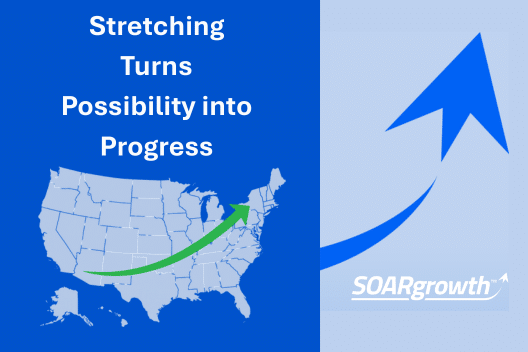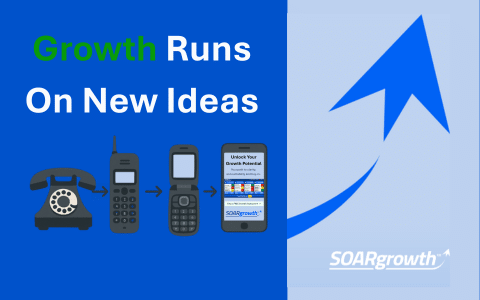By Larry Goddard, Laurence Franklin & Jennifer Goddard
Most middle-market leaders can point to a handful of levers that drive revenue and profit growth—sales, pricing, customer retention, or cost control. But behind every sustained success story lies something less visible yet just as powerful: Organizational Effectiveness.
It’s the infrastructure of human performance—the systems, roles, and culture that determine whether ideas turn into results, whether teams operate with purpose or drift, and whether the business scales smoothly or stalls under its own weight.
At SOARgrowth™, we call Organizational & Culture the “O” Pillar—the backbone that transforms strategy into execution.
When the “O” Pillar is strong, every other pillar (S, A, and R) performs better, faster, and with less friction.
Organizational Effectiveness
How work actually moves through the business.
What it is:
The structures, decision processes, operating rhythm, and cross-functional handoffs that determine speed, quality, and accountability in day-to-day work.
Why it multiplies growth:
Clear roles + crisp decision paths + stable rhythms = fewer do-overs, faster cycle times, cleaner customer experiences, and better margins.
Warning Signs of Low Organizational Effectiveness
- Decisions routinely stall or escalate upward, slowing execution and diluting accountability.
- Teams stay busy, but critical priorities slip through the cracks—with duplicated efforts and unclear ownership.
- Quarterly goals don’t translate into weekly actions, leaving strategy disconnected from daily performance.
- Commitments aren’t kept, causing cynicism to spread and accountability standards to erode.
Key Action Steps to Improve Organizational Effectiveness
- Clarify Roles and Accountability
- Redefine every key role in terms of outcomes, not activities.
- Assign a single accountable owner for each strategic initiative.
- Eliminate overlapping responsibilities that cause confusion or delay.
- Establish an Operating Rhythm
- Lock in a consistent cadence: weekly tactical, monthly performance, and quarterly strategic meetings.
- End every meeting with clear owners, deadlines, and metrics.
- Align Goals and Execution
- Translate annual objectives into quarterly, monthly and weekly priorities.
- Publish simple, visible scorecards so everyone knows what winning looks like.
- Tie each team’s priorities to measurable business outcomes.
- Build a Culture of Follow-Through
- Track commitments and close the loop visibly—celebrate what’s done.
- Use after-action reviews to learn quickly from misses without blame.
- Reinforce accountability through recognition, not reprimand.
- Improve Information Flow
- Replace long updates with short, structured dashboards or KPI summaries.
- Make metrics transparent across teams to reduce rework and misalignment.
- Encourage real-time sharing of insights and obstacles.
- Measure and Refine Continuously
- Review organizational effectiveness metrics quarterly: decision speed, project completion rate, meeting effectiveness, and satisfaction with clarity.
- Treat structure and rhythm as living systems—adjust as the company grows.
Culture & Values
The operating system of the business—how people think, act, treat one another, and make decisions.
What it is:
Not slogans or posters—it’s the daily behaviors, decisions, and interactions that reveal what the company truly values. Culture shows up in how people work together, support one another, handle conflict, and make trade-offs when people are watching, and—more important—when they are not. Values that genuinely guide behavior influence how teams communicate, solve problems, and treat both colleagues and customers.They’re reflected in hiring, feedback, recognition, promotions and consequences—defining the tone of every relationship inside the business.
Why it multiplies growth:
High-trust cultures execute faster with fewer controls. People share issues early, align on priorities, and bring energy to problem-solving—fueling Wallet Share, Win-Backs, and smoother operational execution.
Key Action Steps to Strengthen Culture & Values
- Define the Behaviors Behind the Words
- Translate each core value into three observable “always” and “never” behaviors.
- Embed those behaviors into hiring, onboarding, performance reviews, and promotions.
- Replace vague values (like “Integrity” or “Teamwork”) with actions people can see and measure.
- Model and Reinforce the Right Examples
- Ensure leaders demonstrate the values visibly—especially under pressure or conflict.
- Recognize and share stories of people who live the values while achieving results.
- Use values-based recognition systems that link behavior to business impact.
- Build Psychological Safety and Trust
- Train leaders to listen actively, invite dissenting views, and respond constructively.
- Encourage teams to surface risks and mistakes early without fear of blame.
- Use “after-action” reviews to focus on learning, not fault-finding.
- Integrate Values into Daily Operations
- Open every key meeting with a “values in action” example or customer story.
- Incorporate values into decision frameworks—ask, “Which choice best reflects who we say we are?”
- Align policies, metrics, and rewards so they reinforce—not contradict—cultural priorities.
- Recognize and Correct Behavior Quickly
- Celebrate actions that reflect values and deliver results.
- Address violations swiftly and privately—especially by leaders.
- Use consistent consequences to show that values aren’t optional.
- Measure Cultural Health
- Conduct quarterly pulse surveys focused on trust, collaboration, and respect.
- Track recognition frequency, peer feedback volume, and cross-functional cooperation.
- Discuss culture metrics in leadership meetings with the same rigor as financials.
Culture isn’t built in workshops—it’s built in moments. When people see that values truly guide decisions, interactions, and recognition, trust deepens, energy rises, and performance accelerates. Every interaction either strengthens or weakens it. When values are clear, lived, and reinforced through daily behavior, trust grows, collaboration deepens, and execution accelerates.
Leadership
Creating clarity, confidence, and capability at every level—built on trust, shared vision, and genuine buy-in. Great leaders align people around purpose, empower decisive action, and model the behaviors that inspire others to follow.
What it is:
The daily practice of setting direction, modeling values, developing people, building trust, and removing friction and roadblocks to success.
Why it multiplies growth:
Great leadership compresses time and amplifies impact—by creating clarity of vision, building trust across teams, and generating genuine buy-in. When leaders coach effectively, prioritize decisively, and model accountability, they transform strategy into repeatable habits that scale performance and culture together.
Key Action Steps to Strengthen Leadership
- Clarify the Leadership Standard
- Define what great leadership looks like in your company—specific behaviors, not general traits.
- Include how leaders set direction, build trust, coach others, and model accountability.
- Build Alignment Around Vision and Priorities
- Communicate the vision clearly, consistently, and repeatedly—until everyone can articulate it.
- Connect daily decisions to strategic priorities so teams understand why their work matters.
- Use storytelling to link company goals to personal impact, creating emotional as well as intellectual buy-in.
- Develop Leaders at All Levels
- Identify emerging leaders early and provide stretch assignments to accelerate learning.
- Offer coaching and feedback frameworks that help managers lead through others—not around them.
- Encourage peer mentoring and cross-functional exposure to broaden perspective and trust.
- Model Trust and Transparency
- Share reasoning behind key decisions, even when outcomes are uncertain.
- Admit mistakes and turn them into learning moments—this builds credibility and psychological safety.
- Ensure leaders give and receive feedback regularly, not just during formal reviews.
- Drive Accountability Through Empowerment
- Delegate authority with clear outcomes and guardrails—not tasks and micromanagement.
- Follow up on commitments visibly so accountability becomes a shared discipline.
- Celebrate decisive action, even when results aren’t perfect—speed and ownership matter more than flawless execution.
- Coach for Capability, Not Compliance
- Replace directive management with developmental coaching—ask, don’t tell.
- Focus on helping team members think, decide, and act independently.
- Measure leaders not just by what they achieve, but by how many people they help grow.
- Measure Leadership Impact
- Track leadership effectiveness through 360° feedback, engagement scores, and talent retention.
- Review leadership pipelines quarterly—who’s ready now, who’s ready next.
- Tie leadership development to measurable business outcomes (growth, culture, and execution).
Leadership isn’t a position—it’s a multiplier. When leaders communicate vision clearly, earn trust, and inspire buy-in, they unlock capability and confidence at every level of the business. The result is faster execution, stronger alignment, and a culture that grows leaders as fast as it grows results.
How to Strengthen Your “O” Pillar
Improving organizational effectiveness starts with an honest look at your current state.
Ask yourself—and your leadership team—these questions:
- Do we have the right people in the right roles to achieve our growth goals?
- Are our roles, responsibilities and decision-making processes clear, efficient, and trusted?
- Do our team members understand how their work connects to company strategy?
- Are we spending too much time in meetings without clear outcomes?
- Is accountability clear and consistent across departments?
- Do we empower our people to help improve processes, generate ideas and identify new opportunities or roadblocks?
- Have we built trust and respect into our culture?
If the answers reveal friction, duplication, fatigue, or lack of trust or buy-in, it’s time to revisit your organizational design and rhythms.
The Bottom Line
You don’t scale on strategy alone. You scale on Organizational Effectiveness, Culture & Values, and Leadership working in concert—so decisions are faster, people are trusted and enabled, and managers turn plans into performance. Strengthen the O Pillar, and growth stops feeling uphill—it starts to pull you forward.
Organizational & Culture isn’t a “soft” skill—it’s a hard edge of competitiveness.
You can have the best strategy in the world, but if your organization can’t execute it—consistently, decisively, collaboratively, and enthusiastically—it’s just a plan on paper.
When the structure, culture, and communication of your business align, you don’t have to push growth uphill. It starts to pull you forward.
That’s the power of Organizational & Culture—and it’s why the “O” in SOAR is where many companies find some of their greatest untapped potential.
© Copyright, 2025, The Parkland Group, Inc. All Rights Reserved.



